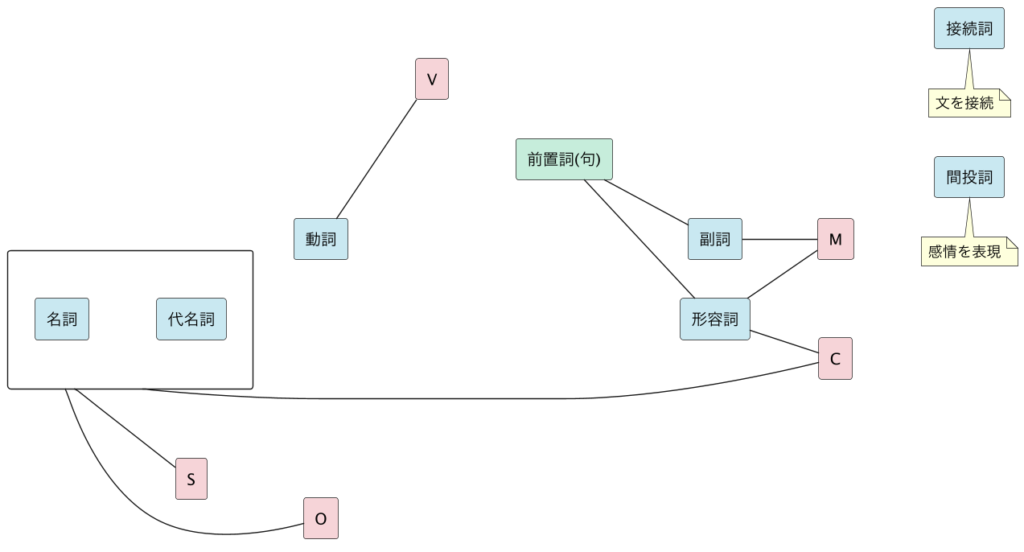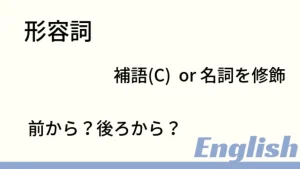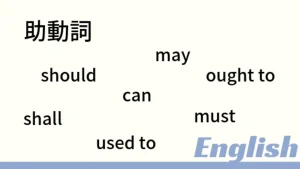英文法の入門として「8つの品詞」「文型」「文の種類」について例文とともに確認する。
これらを把握することで、単語が文中でどのような役割を果たしているかを理解し、適切な語順や構造を選ぶことが可能になる。
英語のリーディング、ライティング、リスニング、スピーキングの各スキルを総合的に向上させるための基盤だ。
品詞
( 単語の役割や種類 )
名詞|Noun|n.
名詞は、人、場所、物、概念などを指す言葉。
- 可算名詞
- 単数(
a[an]がつく ) - 複数(複数形)
- 単数(
- 不可算名詞
- 単数(
a[an]はつかない ) - 例
- 抽象名詞(
angerlovetime) - 物質名詞(
watermoneysmoke)
- 抽象名詞(
- 単数(
代名詞|Pronoun|pron.
名詞の代わりに用いられる言葉。何回も登場する名詞の代わりとなる。
代名詞にはいくつかのカテゴリがあり、それぞれが異なる機能や用途を持つ。
| 代名詞 | 種類 | 例文 |
|---|---|---|
I you she he it we they | 主格 ( 第5文型の Sになれる ) | I am learning English. |
my your her his its our their | 所有格 ( 名詞の前におく ) | My book is on the table. |
me you her him it us them | 目的格 ( 動詞、前置詞が指し示す目的の対象になれる ) | She gave me a gift. |
mine yours hers his its ours theirs | 所有代名詞 ( 名詞の代わりになる ) | This book is mine. |
myself yourself | 反射代名詞 | I made myself a cup of coffee. |
this | 指示代名詞(単数形) | This is my car. |
that | 指示代名詞(単数形) | That was a great movie. |
these | 指示代名詞(複数形) | These are my friends. |
those | 指示代名詞(複数形) | Those were the days. |
who | 疑問代名詞 関係代名詞 | Who is that? The person who called you is my friend. |
whose | 所有を示す疑問代名詞 関係代名詞 | Whose pen is this? I met a man whose brother lives in Canada. |
which | 疑問代名詞 関係代名詞 | Which is yours? The book, which I read last night, was fascinating. |
動詞|Verb|v.
動詞は、行為、状態、存在を表す言葉。
- 種類
- be動詞
- 一般動詞
- 自動詞
- 他動詞
- 変形(不規則もある)
-(e)s- 主語が
3人称単数かつ現在系
- 主語が
-ing- 動詞としてはたらく
- 進行形 ( She is reading a book. )
- 名詞としてはたらく
- 動名詞 ( Reading books is fun. )
- 形容詞としてはたらく
- 現在分詞 ( The crying baby is hungry. )
- 副詞としてはたらく
- 分詞構文 ( Being tired, he went to bed early. )
- 動詞としてはたらく
-ed- 動詞としてはたらく
- 過去形( She walked to school. )
- 過去分詞(完了形・受動態など)
- 現在完了系(have + 過去分詞) ( I have finished my homework. )
- 受動態(be動詞 + 過去分詞) ( The book was written by him. )
- 形容詞としてはたらく
- 過去分詞
- 前置修飾(過去分詞 + 名詞) ( A broken window )
- 後置修飾(名詞 + 過去分詞) ( The letter written by her )
- 過去分詞
- 副詞としてはたらく
- 分詞構文 ( Used properly, this machine will last for years. )
- 動詞としてはたらく
形容詞|Adjective|adj.
名詞代名詞を修飾する。
cute, lovely, Japanese, large, happy, important など
比較で利用するとき変形する。
| 原級 | 比較級 | 最上級 |
|---|---|---|
| slow | slower | slowest |
| large | larger | largest |
| easy | easier | easiest |
| beautiful | more beautiful | most beautiful |
| little | less | least |
| many | more | most |
副詞|Adverb|adv.
名詞 代名詞 以外を修飾する。
つまり、動詞 形容詞 副詞 文全体 を修飾する。
today, here, very, often, quickly など
比較で利用するとき変形する。
| 原級 | 比較級 | 最上級 |
|---|---|---|
| soon | sooner | soonest |
| slowly | more slowly | most slowly |
| much | more | most |
| well | better | best |
前置詞|Preposition|prep.
前置詞 + 名詞(句) の形で 副詞 または 形容詞 として働く。
| 前置詞 | 働き | 例文 | 日本語訳 |
|---|---|---|---|
| at | 場所/時間 | I’ll meet you at 5 pm. | 私は午後5時にあなたに会います。 |
| by | 手段/近く | He came by taxi. | 彼はタクシーで来ました。 |
| in | 場所/時間 | She is in the garden. | 彼女は庭にいます。 |
| on | 表面/日付 | The book is on the table. | 本はテーブルの上にあります。 |
| off | 離れて | The bird flew off the branch. | 鳥は枝から飛び立ちました。 |
| of | 所有/一部 | A page of the book | 本の一ページ |
| with | 手段/伴うもの | She writes with a pen. | 彼女はペンで書きます。 |
| for | 目的/期間 | This gift is for you. | この贈り物はあなたのためのものです。 |
| from | 起点 | I received a letter from him. | 私は彼から手紙を受け取りました。 |
| to | 方向/目的地 | We went to the park. | 私たちは公園に行きました。 |
| about | 主題 | We talk about the weather. | 私たちは天気について話します。 |
| over | 位置(上) | The plane flew over the city. | 飛行機は都市の上を飛びました。 |
| under | 位置(下) | The cat is under the table. | 猫はテーブルの下にいます。 |
| between | 位置(間) | The park is between the river and the school. | 公園は川と学校の間にあります。 |
| among | 位置(複数の間) | She sat among her friends. | 彼女は友達の間に座りました。 |
| through | 通過 | We walked through the forest. | 私たちは森を通って歩きました。 |
| into | 移動(内部へ) | He went into the house. | 彼は家の中に入りました。 |
| across | 横切って | We swam across the lake. | 私たちは湖を横断して泳ぎました。 |
| behind | 位置(後ろ) | The ball is behind the sofa. | ボールはソファの後ろにあります。 |
| near | 位置(近く) | She lives near the school. | 彼女は学校の近くに住んでいます。 |
接続詞|Conjunction|conj.
語と語 句と句 節と節 文と文 といった項目同士を接続する役割を持つ。
等位接続詞
- 同じ種類の要素(語・句・節)を対等な関係で結ぶ。
- 主語+動詞(独立した節)をつなぐ場合、カンマ(,)を使うことが多い。
| 接続詞 | 働き | 例文 | 日本語訳 |
|---|---|---|---|
| and | 追加、列挙 | She bought apples and oranges. | 「彼女はリンゴとオレンジを買った。」 |
| or | 選択、代替 | Do you prefer tea or coffee? | 「お茶とコーヒーでは、どちらが好きですか?」 |
| but | 対比、対照 | He is old but healthy. | 「彼は年を取っているが、健康だ。」 |
| so | 結果、帰結 | It was raining, so we stayed indoors. | 「雨が降っていたので、私たちは室内にいた。」 |
従属接続詞
- 主節(独立節)と従属節(従属節単体では文として成立しない)をつなぐ。
- 従属節が先にくる場合、主節との間にカンマ(,)を置くことが多い。
| 接続詞 | 働き | 例文 | 日本語訳 |
|---|---|---|---|
| if | 条件 | If it rains, we will cancel the trip. | 「もし雨が降ったら、私たちは旅行を中止するだろう。」 |
| because | 理由、原因 | We stayed home because it was raining. | 「雨が降っていたので、私たちは家にいた。」 |
| when | 時間 | When I arrived, they were already there. | 「私が到着したとき、彼らはすでにそこにいた。」 |
| as | 理由、同時発生 | As I was leaving, the phone rang. | 「私が出かけようとしていたとき、電話が鳴った。」 |
| although | 譲歩 | Although it was raining, we went for a walk. | 「雨が降っていたけれども、私たちは散歩に出かけた。」 |
| since | 理由、時点から | Since we met, we have been close friends. | 「私たちが出会って以来、親しい友人でいる。」 |
| unless | 条件(否定形) | Unless you study harder, you will not pass the exam. | 「もっと一生懸命勉強しないと、試験に合格しないよ。」 |
| while | 対比、同時発生 | While I enjoy hiking, my brother prefers swimming. | 「私はハイキングが好きだが、兄は泳ぐことを好む。」 |
接続副詞
- 接続詞ではなく、副詞として独立した文をつなぐ。
- 前の文との論理的関係を示す。
| 接続詞 | 働き | 例文 | 日本語訳 |
|---|---|---|---|
| though | 譲歩(文末でも使用可) | It was raining. We went for a walk, though. | 「雨が降っていた。それでも私たちは散歩に出かけた。」 |
| therefore | 結果、帰結 | He was ill; therefore, unable to attend the meeting. | 「彼は病気だったので、会議に出席できなかった。」 |
| however | 対比、対照 | I wanted to buy the book; however, it was too expensive. | 「その本を買いたかったが、高すぎた。」 |
| moreover | 追加の情報 | The plan is risky; moreover, it’s expensive. | 「その計画は危険だ。その上、高い。」 |
間投詞|Interjection|int.
喜怒哀楽や呼びかけを表す。
dear(まあ!)
damn(しまった)
Come on!(さあ)
Excellent!
Wonderful!
文型(SVOCM)
( 単語・句の配置を決める規則 )
SVOCMは、英語の文型を分析する際に用いられる概念で、文の基本的な構造を示す。
| 要素 | 説明 | 例文 |
|---|---|---|
| S (Subject) | 主語。動作や状態の主体。 | Tom laughs. (トムは笑う。) |
| V (Verb) | 動詞。動作や状態を表す。 | Tom laughs. (トムは笑う。) |
| O (Object) | 目的語。動詞の作用を受ける人や物。 | Tom eats an apple. (トムはリンゴを食べる。) |
| C (Complement) | 補語。主語や目的語を説明し、補完する情報。 | Tom is a teacher. (トムは先生です。) |
| M (Modifier) | 修飾語。文の他の要素を修飾し、追加情報を提供。 | Tom eats an apple quickly. (トムはリンゴを素早く食べる。) |
以下のように、品詞ごとに、なれる要素が決まっている。

英語には主に5つの基本文型がある。それぞれの文型と、その文型でよく使われる代表的な動詞を示す。
1. S + V(自)
[ Sは〜する ]
exist live stay go walk run start increase などの動詞が第1文型を作る。
| 例文 | 日本語訳 |
|---|---|
| Birds fly. | 鳥は飛ぶ。 |
| Fish swim. | 魚は泳ぐ。 |
| Children play. | 子供たちは遊ぶ。 |
2. S + V(自) + C
[ S=Cである(になる) ]
Cには 名詞 か 形容詞 のみ指定できる。
be look appear become get make feel などの動詞が第2文型を作る。
| 例文 | 日本語訳 |
|---|---|
| He is tall. | 彼は背が高い。 |
| The soup tastes delicious. | そのスープは美味しい。 |
| They became friends. | 彼らは友達になった。 |
3. S + V(他) + O
[ Sは〜する、Oを ]
主語が動詞の動作を行い、その動作の対象となる目的語がある。動詞は他動詞。
eat read watch love などの動詞が第3文型を作る。
| 例文 | 日本語訳 |
|---|---|
| She loves coffee. | 彼女はコーヒーが好きだ。 |
| The cat chased the mouse. | 猫がネズミを追いかけた。 |
| I read the book. | 私はその本を読んだ。 |
4. S + V(他) + O1 + O2
[ Sは〜する、O1にO2を ]
give offer pass tell pay buy find make などの動詞が第4文型を作る。
| 例文 | 日本語訳 |
|---|---|
| I gave her a gift. | 私は彼女にギフトをあげた。 |
| She told me a secret. | 彼女は私に秘密を教えた。 |
| He sent his friend an email. | 彼は友人にメールを送った。 |
5. S + V(他) + O + C
[ Sは〜する、O=Cという状態を ]
think feel find make leave call などの動詞が第5文型を作る。
| 例文 | 日本語訳 |
|---|---|
| They elected him president. | 彼らは彼を大統領に選んだ。 |
| She considers the plan feasible. | 彼女はその計画を実行可能と考える。 |
| We named our dog Rocky. | 私たちは私たちの犬をロッキーと名付けた。 |
使役動詞、知覚動詞
SVOC文型では、使役動詞や知覚動詞がよく使われる。
使役動詞は、他の人や物に何かをさせる(行わせる)動作を表す。
make let have get などがある。
知覚動詞は、感覚や知覚を表す動詞で、見る、聞く、感じるなどの感覚的な行為を示す。
see hear feel watch などがある。
「C(補語)」の部分には原型不定詞が来ることが多い。
原型不定詞(to + 動詞の原形)は、使役動詞や知覚動詞の後によく用いられ、行為や状態の具体的な内容を示す。
ただし、使役動詞「make」や知覚動詞の後では「to」を省略するのが一般的。
V + O + C | 例文 | 補足 |
|---|---|---|
使役動詞 + O + 原形不定詞 | She made her sister clean the room. (彼女は妹に部屋を掃除させた。) | 受け身の時は to不定詞 にする。Her sister was made to clean the room (by her). (彼女によって、妹は部屋を掃除させられた。) |
知覚動詞 + O + 原形不定詞 | I heard him play the piano. | 全動作を聞いた。受け身の時は to不定詞 にする。 |
知覚動詞 + O + ~ing | I heard him playing the piano. | 一部動作を聞いた。受け身の時も ~ing。 |
文の種類
( 文の目的 )
4つの文( 平叙文 疑問文 命令文 感嘆文 ) がある。
平叙文疑問文命令文は、肯定文否定文の形式を持つ。感嘆文は、肯定文の形式のみ持つ。
平叙(へいじょ)文|declarative sentence
be動詞
| 肯定 | 否定 |
|---|---|
The basic concept is simple. | The basic concept isn't simple. |
一般動詞
| 肯定 | 否定 |
|---|---|
You install the Docker Toolbox software. | You don't install the Docker Toolbox software. |
助動詞 + 動詞(原型)
| 肯定 | 否定 |
|---|---|
Your machine must have a 64-bit operating system. | The volumename must not begin with a /. |
疑問文|interrogative sentence
be動詞
| 肯定 | 否定 |
|---|---|
Is that a typo? | Isn't that a typo? |
一般動詞
| 肯定 | 否定 |
|---|---|
Does it give you information? | Doesn’t it give you information? |
助動詞 + 動詞(原型)
| 肯定 | 否定 |
|---|---|
Can I use json instead of yaml for my Compose file? | Can't I share .vue files directly? |
命令文|imperative sentence
| 肯定 | 否定 |
|---|---|
Call the store method. | Don't call the store method. |
感嘆文|exclamatory sentence
| 肯定 |
|---|
What an interesting book this is! |
How kind she is! |
What + (a[an]+) 形容詞 + 名詞 + S + V!
How + 形容詞[副詞] + S + V!

